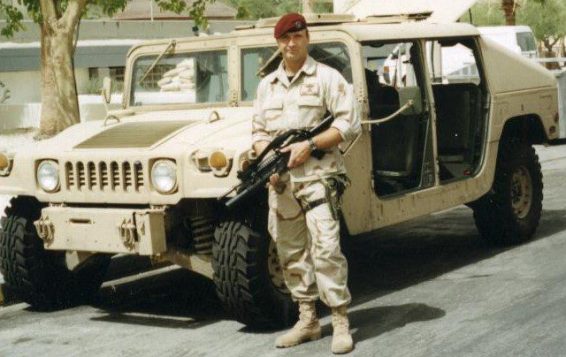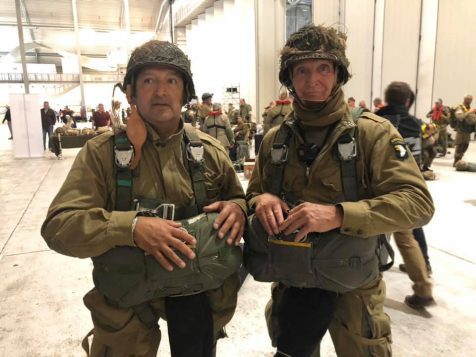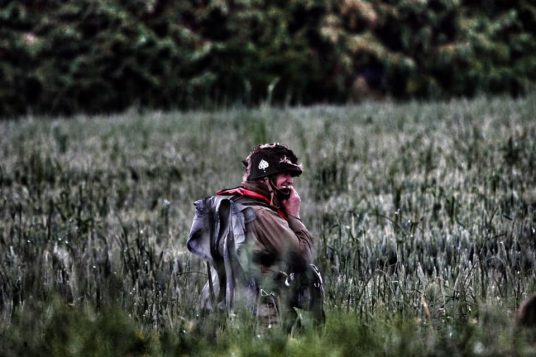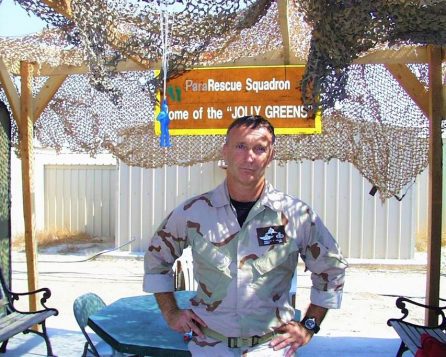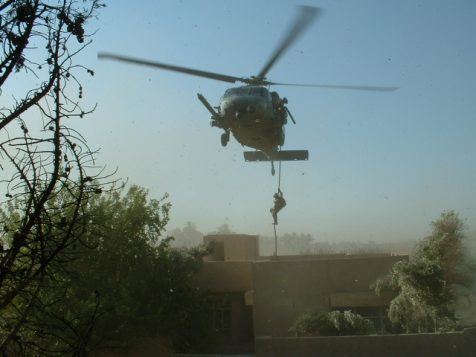By Daniel Dunaief
Tim Malloy worked behind the scenes at highly visible military operations between 1976 and 2003. The fast twitch Malloy, who grew up in Islip and currently lives in Baiting Hollow, was frequently on high alert with his team of US Air Force Combat Pararescuemen.
Part of an elite group of soldiers with extensive and demanding training, Malloy, who retired as a Chief Master Sergeant, waited 15 miles away aboard a C-130 plane during Space Shuttle launches, prepared to jump into the water to provide assistance to astronauts in the event of an emergency.
In addition to heading into violent and dangerous storms, Malloy traveled to countries including Turkey, Kuwait, Saudi Arabia, and Iraq as part of the Air Force’s efforts to protect and retrieve troops.
Malloy and his fellow pararescuemen recognized the dangers of their job. “Every time you get in an airplane, you don’t know if it’s going to come back,” he said. “It’s a humbling feeling.”
A friend from childhood who Malloy convinced to become a pararescueman, David Ruvola suggested that Malloy is the kind of partner in arms other members of the military hope to find.
“When you’re dealing with life and death situations, you want the guy next to you that’s going to put his life on the line for yours,” Ruvola said. “You have to have the mindset of ‘if I lose my life trying to save my brother next to me, guess what, I’m going.’ There’s no question that [Malloy] is that kind of guy.”
Malloy and Ruvola were a part of a unit that supported efforts in Iraq.
During a firefight outside Abu Ghraib prison 20 years ago, a Humvee with several soldiers aboard rolled into a waterway. Without a moment’s hesitation, another soldier, Andrew Baddick, dove into the water to try to rescue the crew. Ruvola, who was a squadron commander during a time when Malloy was a pararescueman, were called to the scene.
The pararescue squad was the only one in the country with scuba tanks, although those tanks didn’t have any air. Ruvola filled them up in a firehouse and sent two helicopters, including Malloy to the scene.
Malloy and his team entered the dirty water, where they traveled hand over hand to find the fallen soldiers, including Baddick. “It took us quite a while, but we recovered the bodies,” Malloy said.
Emotional meeting
About a decade after recovering the soldiers, Malloy was at a camper show in Hershey Park, Pennsylvania, where about 50,000 people attended. He noticed a man wearing a gold star hat, which meant he had lost a family member during a conflict. Malloy expressed his sympathies. When the father told his story, Malloy recognized the details. “I recovered your son’s body,” Malloy told Joseph Baddick, who was Andrew’s father. “I remember the whole thing.”
At lunch that day, Malloy shared details with Baddick about his son. “He didn’t know the nuts and bolts of the whole thing,” Malloy said. “It was, by far, one of the most emotional moments for me in the military.”
Sea rescues
In addition to high profile missions or rescue attempts, Malloy experienced some challenging and high risk efforts that were part of his Air Force responsibilities.
After a Portuguese ship sank, four fisherman were in a life raft designed for three people. Malloy and another rescue man jumped from a helicopter and swam to the raft in frigid waters in the middle of November. Suffering from hypothermia, the fishermen weren’t thinking clearly and had started taking off their clothing.
The Air Force crew raised the fisherman, who had pink skin from the cold, into the helicopter. One of Malloy’s crew got into a sleeping bag with a fisherman to help raise his body heat. In the cold helicopter, the crew administered intravenous fluids they had preheated.
“As the blood was getting back into their body, they started shivering violently,” Malloy said, which was a good sign that they were starting to warm up.
In a separate incident, the appendix of a man aboard a tanker in the middle of the ocean burst. Malloy and another rescuer jumped out of a C-130 in the middle of the night and swam to the ship, where they relied on their training as emergency medical technician at a paramedic level to treat the crew member.
A life changing article
When he was young, Malloy recalled how people stood when the flag went by during Flag Day and Veteran’s Day. He enjoyed the hot dogs and soda he consumed at the American Legion after attending parades.
After he graduated from Islip High School, Malloy wasn’t sure what he’d do with his life. “I ended up reading an article in the Daily News about guys who jumped out of planes and rescued people,” he said. “I mentioned in to my mom and she said, ‘it sounds like it’s right up your alley.’”
The training was more difficult than he thought, especially because, despite being playing lacrosse, basketball and football, he wasn’t much of a swimmer. Even with the Air Force’s effort to weed out people, he didn’t believe quitting was an option.
Sounding like Richard Gere in the movie An Officer and a Gentleman, Malloy said he had “nothing to go back to.” Being surrounded by like-minded men raised Malloy’s game, making him work harder.
His military experience “fit my personality and lifestyle and worked for me,” Malloy said. He joined the Suffolk County Police Department after he retired, where he worked until 2018. The military “taught me how to treat people,” he said. Even some of the people he arrested thanked him for how he interacted with them.
Normandy
After he retired from the police force, Malloy heard about an effort to recreate the 75th anniversary of the Allied Forces’ attack at Normandy. He signed up to jump out of an airplane. The participants had to have 15 recent jumps to qualify, which he did by jumping out of planes in Oklahoma, Florida and Texas. Wearing original combat uniforms and jumping out of a restored airplane from the invasion, Malloy, who was the only New Yorker in the anniversary jump, was on the first plane from which soldiers parachuted into a poppy field in France. French residents came up to him and thanked him for coming.
In the United States, Malloy appreciates the treatment veterans receive from most civilians.“It’s a really good feeling,” he said. “I get treated with a lot of respect.”

